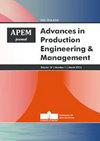Neuro-mechanistic model for cutting force prediction in helical end milling of metal materials layered in multiple directions
IF 2.8
3区 工程技术
Q2 ENGINEERING, MANUFACTURING
引用次数: 8
Abstract
In machining of multi‐layer metal materials used frequently for the manufac‐ ture of transfer sheet‐metal forming tools, the cutting edge is often damaged because of cutting force peaks. Therefore, a neuro‐mechanistic model, pre‐ sented in this paper, has been created for accurate prediction of cutting forces in helical end milling of multidirectional layered materials. The generalized model created takes into account the complex geometry of the helical end milling cutter, the instantaneous chip thickness and the direction of deposit‐ ing of the individual layer of the multidirectional layered material considered in the calculation through predicted specific cutting forces. For the prediction of specific cutting forces for individual layers a neural network is incorpo‐ rated in the model. The comparison with experimental data shows that the model predicts accurately the flow of cutting force in milling of multidirec‐ tional layered metal materials for any combination of cutting parameters, tool engagement angle and directions of depositing three layers of material. The predicted cutting force values agree well with the values obtained, the maxi‐ mum error of predicted cutting forces is 16.1 % for all comparison tests per‐ formed. © 2020 CPE, University of Maribor. All rights reserved.多方向分层金属材料螺旋立铣削切削力预测的神经机制模型
在多层金属材料的加工中,由于切削力的峰值,切削刃经常被损坏。因此,本文提出了一种神经机制模型,用于准确预测多向层状材料螺旋立铣削时的切削力。建立的广义模型考虑了螺旋立铣刀的复杂几何形状、瞬时切屑厚度以及计算中考虑的多向分层材料各层的沉积方向,通过预测特定的切削力。为了预测个别层的特定切削力,在模型中加入了神经网络。与实验数据的比较表明,该模型能够准确地预测出在切削参数、刀具啮合角和三层材料沉积方向任意组合下多方向层状金属材料铣削过程中的切削力流动。预测的切削力值与实测的切削力值吻合较好,在每个成形的所有对比试验中,预测的切削力最大误差为16.1%。©2020 CPE,马里博尔大学。版权所有。
本文章由计算机程序翻译,如有差异,请以英文原文为准。
求助全文
约1分钟内获得全文
求助全文
来源期刊

Advances in Production Engineering & Management
ENGINEERING, MANUFACTURINGMATERIALS SCIENC-MATERIALS SCIENCE, MULTIDISCIPLINARY
CiteScore
5.90
自引率
22.20%
发文量
19
期刊介绍:
Advances in Production Engineering & Management (APEM journal) is an interdisciplinary international academic journal published quarterly. The main goal of the APEM journal is to present original, high quality, theoretical and application-oriented research developments in all areas of production engineering and production management to a broad audience of academics and practitioners. In order to bridge the gap between theory and practice, applications based on advanced theory and case studies are particularly welcome. For theoretical papers, their originality and research contributions are the main factors in the evaluation process. General approaches, formalisms, algorithms or techniques should be illustrated with significant applications that demonstrate their applicability to real-world problems. Please note the APEM journal is not intended especially for studying problems in the finance, economics, business, and bank sectors even though the methodology in the paper is quality/project management oriented. Therefore, the papers should include a substantial level of engineering issues in the field of manufacturing engineering.
 求助内容:
求助内容: 应助结果提醒方式:
应助结果提醒方式:


